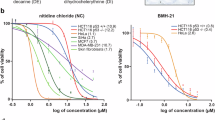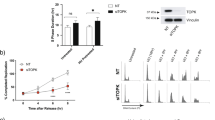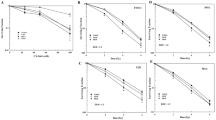Abstract
G2 checkpoint inhibitors can force cells arrested in G2 phase by DNA damage to enter mitosis. In this manner, several G2 checkpoint inhibitors can enhance killing of cancer cells by ionizing radiation and DNA-damaging chemotherapeutic agents, particularly in cells lacking p53 function. All G2 checkpoint inhibitors identified to date target protein phosphorylation by inhibiting checkpoint kinases or phosphatases. Using a phenotypic cell-based assay for G2 checkpoint inhibitors, we have screened a large collection of plant extracts and identified Z-Cryptofolione and Cryptomoscatone D2 as highly efficacious inhibitors of the G2 checkpoint. These compounds and related pyrones also inhibit nuclear export. Leptomycin B, a potent inhibitor of Crm1-mediated nuclear export, is also a very potent G2 checkpoint inhibitor. These compounds possess a reactive Michael acceptor site and do not appear promising as a radiosensitizing agents because they are toxic to unirradiated cells at checkpoint inhibitory concentrations. Nevertheless, the results show that inhibition of nuclear export is an alternative to checkpoint kinase inhibition for abrogating the G2 checkpoint and they should stimulate the search for less toxic nuclear export inhibitors.



Similar content being viewed by others
Explore related subjects
Discover the latest articles and news from researchers in related subjects, suggested using machine learning.References
Sancar A, Lindsey-Boltz LA, Unsal-Kacmaz K, Linn S (2004) Molecular mechanisms of mammalian DNA repair and the DNA damage checkpoints. Annu Rev Biochem 73:39–85
Prudhomme M (2006) Novel checkpoint 1 inhibitors. Recent patents on anti-cancer drug discovery, 1,pp 55–68
Garber K (2005) New checkpoint blockers begin human trials. J Natl Cancer Inst 97:1026–8
Roberge M, Berlinck RGS, Xu L, Anderson HJ, Lim LY, Curman D, Stringer CM, Friend SH, Davies P, Vincent I, Haggarty SJ, Kelly MT, Britton R, Peirs E, Andersen RJ (1998) High-throughput assay for G2 checkpoint inhibitors and identification of the structurally novel compound isogranulatimide. Cancer Res 58:5701–6
Rundle NT, Xu L, Andersen RJ, Roberge M (2001) G2 DNA damage checkpoint inhibition and antimitotic activity of 13-hydroxy-15-oxozoapatlin. J Biol Chem 276:48231–6
Love DC, Sweitzer TD, Hanover JA (1998) Reconstitution of HIV-1 rev nuclear export: independent requirements for nuclear import and export. Proc Natl Acad Sci USA 95:10608–13
Nehme CJ, Bastos WL, Araujo Ajd, Cavalheiro AJ (2005) An HPLC-PAD method to analyse flavonoid glycosides and styrylpyrones from Cryptocarya species (Lauraceae). Phytochem Anal 16:93–7
Sehlapelo BM, Drewes SE, Scott-Shaw R (1994) A 6-substituted 5,6-dihydro-a-pyrone from two species of Cryptocarya. Phytochemistry 37:847–9
Sturgeon CM, Craig K, Brown C, Rundle NT, Andersen RJ, Roberge M (2005) Modulation of the G2 cell cycle checkpoint by sesquiterpene lactones psilostachyin A and C isolated from the common ragweed Ambrosia artemisiifolia. Planta Med 71:949–54
Meissner T, Krause E, Vinkemeier U (2004) Ratjadone and leptomycin B block CRM1-dependent nuclear export by identical mechanisms. FEBS Lett 576:27–30
Paull KD, Shoemaker RH, Hodes L, Monks A, Scudiero DA, Rubinstein L, Plowman J, Boyd MR (1989) Display and analysis of patterns of differential activity of drugs against human tumor cell lines: development of mean graph and COMPARE algorithm. J Natl Cancer Inst 81:1088–92
Farjot G, Sergeant A, Mikaelian I (1999) A new nucleoporin-like protein interacts with both HIV-1 Rev nuclear export signal and CRM-1. J Biol Chem 274:17309–17
Nishi K, Yoshida M, Fujiwara D, Nishikawa M, Horinouchi S, Beppu T (1994) Leptomycin B targets a regulatory cascade of crm1, a fission yeast nuclear protein, involved in control of higher order chromosome structure and gene expression. J Biol Chem 269:6320–4
Haggarty SJ, Koeller KM, Kau TR, Silver PA, Roberge M, Schreiber SL (2003) Small molecule modulation of the human chromatid decatenation checkpoint. Chem Biol 10:1267–79
Toyoshima F, Moriguchi T, Wada A, Fukuda M, Nishida E (1998) Nuclear export of cyclin B1 and its possible role in the DNA damage-induced G2 checkpoint. EMBO J 17:2728–35
Takizawa CG, DO Morgan (2000) Control of mitosis by changes in the subcellular location of cyclin-B1-Cdk1 and Cdc25C. Curr Opin Cell Biol 12:658–65
Davezac N, Baldin V, Gabrielli B, Forrest A, Theis-Febvre N, Yashida M, Ducommun B (2000) Regulation of CDC25B phosphatases subcellular localization. Oncogene 19:2179–85
Lindqvist A, Kallstrom H, Karlsson Rosenthal C (2004) Characterization of Cdc25B localization and nuclear export during the cell cycle and in response to stress. J Cell Sci 117:4979–4990
Graves PR, Lovly CM, Uy GL, Piwnica-Worms H (2001) Localization of human Cdc25C is regulated both by nuclear export and 14–3-3 protein binding. Oncogene 20:1839–1851
Yashiroda Y, Yoshida M (2003) Nucleo-cytoplasmic transport of proteins as a target for therapeutic drugs. Curr Med Chem 10:741–8
Thomas F, Kutay U (2003) Biogenesis and nuclear export of ribosomal subunits in higher eukaryotes depend on the CRM1 export pathway. J Cell Sci 116:2409–1419
Newlands ES, Rustin GJ, Brampton MH (1996) Phase I trial of elactocin. Br J Cancer 74:648–9
Acknowledgments
We thank G. Cragg and D. Newman for access to the NCI Natural Products Repository and H. Anderson for helpful discussions. This work was supported by grants from the National Cancer Institute of Canada with funds from the Canadian Cancer Society (MR and RJA).
Author information
Authors and Affiliations
Corresponding author
Rights and permissions
About this article
Cite this article
Sturgeon, C.M., Cinel, B., Díaz-Marrero, A.R. et al. Abrogation of ionizing radiation-induced G2 checkpoint and inhibition of nuclear export by Cryptocarya pyrones. Cancer Chemother Pharmacol 61, 407–413 (2008). https://doi.org/10.1007/s00280-007-0483-y
Received:
Accepted:
Published:
Issue Date:
DOI: https://doi.org/10.1007/s00280-007-0483-y




